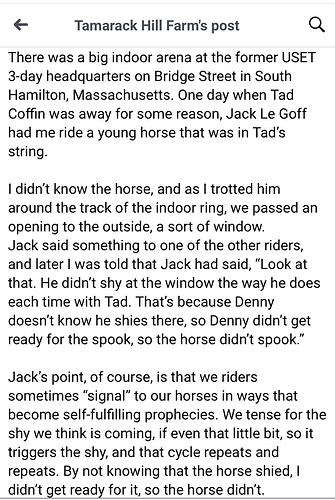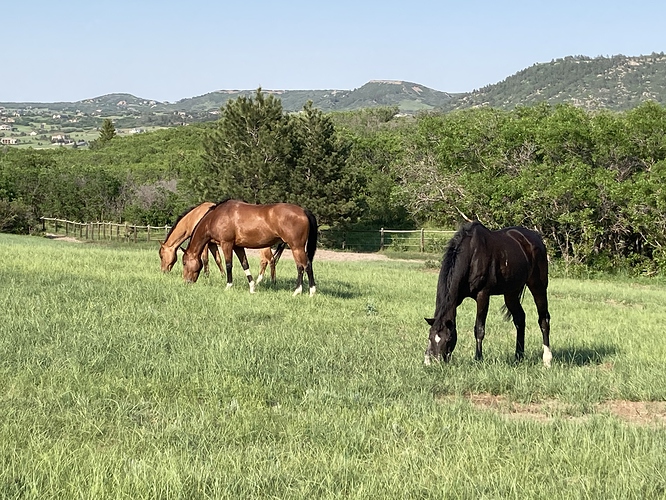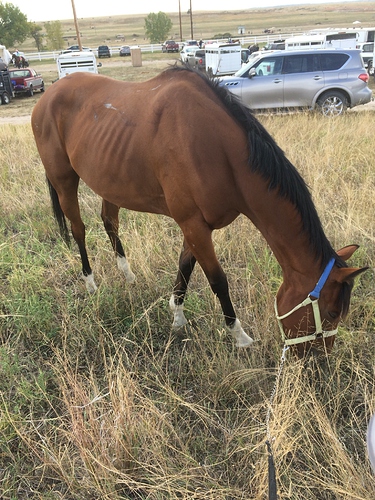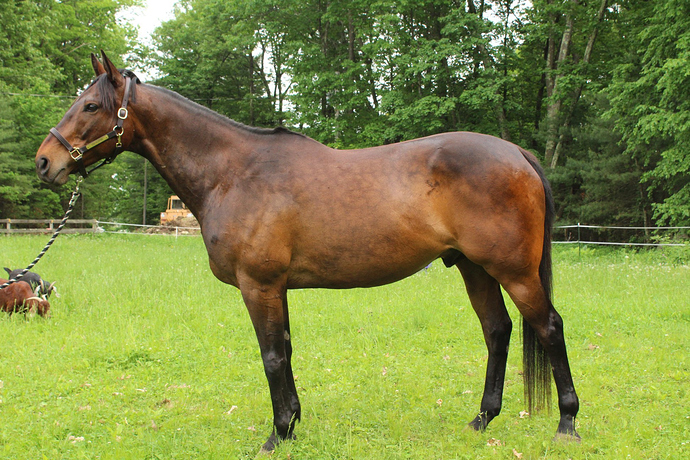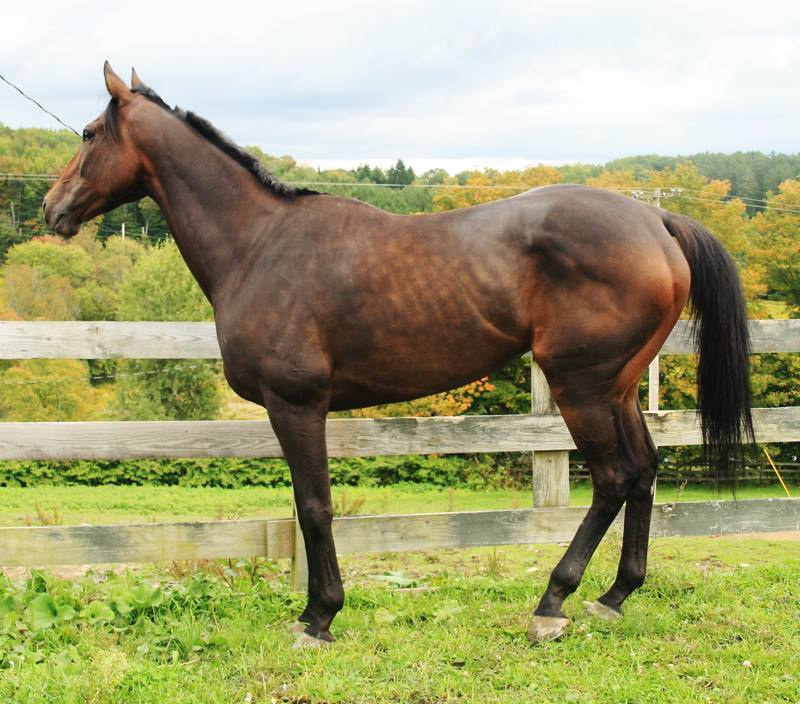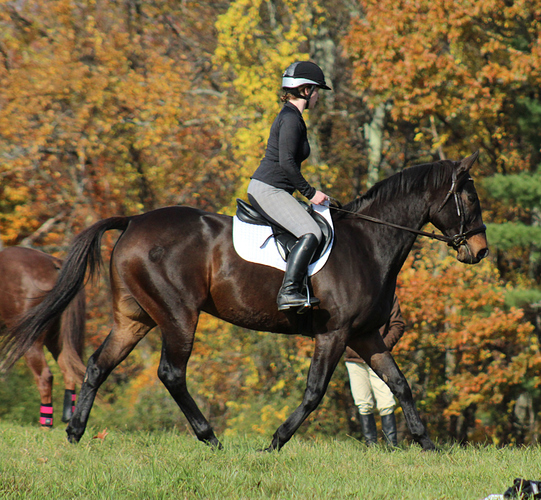Same with a good mal. 
I have not read the whole thread, but this seemed like a timely article.
I think this is part of the problem people have. 1 hour 3 days a week isn’t enough to keep a lot of them going well. They need to WORK.
Wow. This one - stunning!
Love this story. The only thing I object to is the “he doesn’t look like a thoroughbred”, um he looks like a lot of tb’s. A big bodied horse with nice legs can actually be a thoroughbred.
I often comment to my trainer that my horse’s work ethic is directly correlated to my own—if I ask him to work six days a week he’ll rise to that occasion, I just have to get myself out there. If I let him sit around and don’t ask him to engage his brain regularly, he responds with a corresponding level of effort when I do get on.
We also frequently discuss this: are many of the stereotypes that people attribute to Thoroughbreds actually true, or are they self-fulfilling prophecies created by the expectations that people have of Thoroughbreds which impact the way those people handle/care for them?
Having tb’s changed my pasture and stall management and certainly changed my riding. I didn’t expect them to be ready to go 24/7, they showed me. My mare was more lame than not for over two years. Once she stayed sound I jumped on her with just a halter and lead rope and rode her down the road to a trail. No spooking, no bucking, just her usual demeanor of ‘here we go’ and she power walked on.
Several people at the barn were afraid to handle her because she was big and wouldn’t tolerate wittering. But she never bit, kicked, stepped on you, ran you over, bucked, reared, etc. They were afraid just because she was big and wanted to move.
Love this story. The only thing I object to is the “he doesn’t look like a thoroughbred”, um he looks like a lot of tb’s. A big bodied horse with nice legs can actually be a thoroughbred.
Lovely horse, but I agree with you. It’s almost as if the trainer is saying that the horse is so good because of NOT being like a TB. "I couldn’t believe he was a Thoroughbred; he moved so well.”
“Moves like a TB” is, in my opinion, code for the fact that a lot of people picking up OTTBs are doing it because they’re cheap and are not great riders who know what right feels like and therefore can’t teach them to go properly. When the horse is undermuscled/muscled upside down, probably underweight, and likely not getting the greatest farrier care, are we really surprised that they’re not moving well? Really? I don’t think breed has much to do with it (and a weirdly-built horse is just a weirdly-built horse, no one has a monopoly on that either).
I say this as someone who could never afford to sit on premade “right” and has had to learn what it is alongside my horse after getting him through some physical issues (caused by bad farrier work, not him being a TB) (all of this thankfully under the guidance of my incredibly competent trainer). The number of times I’ve heard “oh, that’s nice” when he lifts his back and properly engages his hind end… He’s not even properly in shape yet post-rehab and it’s already night and day from when I bought him. He doesn’t have the over-exaggerated crazy suspension that you get from some warmbloods, but it’s definitely fluffy and so comfortable to ride (and doesn’t make me fear for the future of his joints).
I think I’ve said it on COTH before, but we joke frequently that I should take him out showing and not tell anyone that he’s a TB just to see how many people mistake the shiny round big bay thing for a warmblood. My trainer’s TB is the same. They look like big bay sporthorses because that’s exactly what they are. That they lived a prior life just means the work ethic was installed early.
“Moves like a TB” is, in my opinion, code for the fact that a lot of people picking up OTTBs are doing it because they’re cheap and are not great riders who know what right feels like and therefore can’t teach them to go properly. When the horse is undermuscled/muscled upside down, probably underweight, and likely not getting the greatest farrier care, are we really surprised that they’re not moving well? Really? I don’t think breed has much to do with it (and a weirdly-built horse is just a weirdly-built horse, no one has a monopoly on that either).
This is all true, but I will say it was a bit of an eye opener to go back to feeding a big TB. I’ve been lucky that my other one is, and was during his show career, a very easy keeper.
My current 16.3h 84” model eats me out of house and home, and is nothing like feeding the barns full of show horses I managed. Keeping him at a respectable weight is an entirely different undertaking, and I understand how people struggle to both afford and manage it, especially when they aren’t surrounded by great examples of well maintained TBs.
It’s so true! All of my TBs were like teenage boys, and it was a constant struggle to make sure they were getting what they needed. My two WB tubes I have now are in a barn full of big, burly TB event horses, and while all of their neighbors have nets stuffed with alfalfa and some grass hay, mine have grass hay and one small diet flake of alfalfa (it’s very sad for them  ). My last TB was built big, too, and I felt like I could never feed him enough.
). My last TB was built big, too, and I felt like I could never feed him enough.
I must say I find the mounds of food needed to be so much better than an air fern. I loved making up my tb’s meals. I felt like a scientist adding a dash of this, a pinch of that, a cup of those, etc.  But honestly the item that kept a nice weight on were alfalfa pellets. So I could do little concoctions as long as there was at least a pound of pellets. Adding carrots and other treats satisfied my motherly feeder need. I had one horse that had to stay on a limited diet and that was as hard on me as him. (he was 1/2 Arab, total air fern)
But honestly the item that kept a nice weight on were alfalfa pellets. So I could do little concoctions as long as there was at least a pound of pellets. Adding carrots and other treats satisfied my motherly feeder need. I had one horse that had to stay on a limited diet and that was as hard on me as him. (he was 1/2 Arab, total air fern)
We also frequently discuss this: are many of the stereotypes that people attribute to Thoroughbreds actually true, or are they self-fulfilling prophecies created by the expectations that people have of Thoroughbreds which impact the way those people handle/care for them?
On that subject:
https://www.facebook.com/story.php?story_fbid=929884145836611&id=100064451033652
Here’s a screenshot for those who don’t do Facebook.
All of my TBs were like teenage boys, and it was a constant struggle to make sure they were getting what they needed
FWIW, so far mine have all outgrown this phase! And I’m crossing my fingers my 5yo will too  . He eats like an event horse in full work, while the 12yo gets a balancer and a bit of grain so his bucket doesn’t look pathetic (and he’s FAT). 12yo ate like an event horse at this age too, but I can’t recall when that stopped
. He eats like an event horse in full work, while the 12yo gets a balancer and a bit of grain so his bucket doesn’t look pathetic (and he’s FAT). 12yo ate like an event horse at this age too, but I can’t recall when that stopped 
It’s true though that OTTBs are relatively cheap to obtain vs your average WB, and some people may not be prepared to support such a horse. If you’re used to air ferns like your average pony breed or QH, stuffing 30,000 calories of alfalfa and high quality feed into a horse that’s just flatting around seems insane. So obviously it’s the breed that’s making them skinny and ulcery and have crumbly feet… meanwhile that $50k+ import has a nutritionist and the best farrier care money can buy. That’s before we even start talking about the quality of riding and training.
Yesterday I saw a side by side comparison of an OTTB mare over 3 months. First video was of a fussy, undermuscled, sewing machine mover who would easily be clocked as a TB by your average HJ rider. The second video showed an attractive, relaxed, sweeping mover who wouldn’t look out of place at a show. Same horse, just clearly being managed by people who understand TBs and how to develop them.
From three years ago (top) to a few weeks after I got Peanut off the track (2017). The intent is to show what is being discussed in terms of management. Track horses eat an insane amount of calories per day but they also have fitness programs rivaling any world class human runner. They run light and fit. They are by no means starved.
Performance horses require a very different approach and it takes a long period of transition to move from one to another.
Track horses eat an insane amount of calories per day but they also have fitness programs rivaling any world class human runner. They run light and fit. They are by no means starved.
To be clear, I don’t think they’re underweight at the track (and this is a general remark, not at Reed). As has already been noted, many people do a terrible job of transitioning them afterward and they blame it on the fact that they’ve got a TB, not the fact that they aren’t managing that change properly. My trainer’s horse has been getting as much hay as he’ll eat, three quarts of grain twice a day, and “snacks” whenever he’s in to be ridden for the last year, and it’s only in the last month or two that he’s started looking like a “real” horse after being off the track since last October.
We’re definitely a bit spoiled on the dietary front though. My horse is in a group of six in a 17-acre field so there’s never any shortage of grass (they’re on it near-24/7 spring through fall and only come in for their grain/supplements, and have round bales when they’re out during the day over the winter. My barn has 20 horses total on ~80 acres of pasture), our hay comes from ten minutes down the road, and my trainer refuses to subscribe to the idea that every horse only gets X number of flakes per day—they get as much as they’ll eat (first cut) except for the ponies who aren’t allowed to have that much for health reasons. The second cut is reserved for the true hard keepers and the old guys.
My horse was hard to keep weight on when he was still growing but that’s over now aside from muscle building. When they’re out all the time with all the grass he gets a handful of grain and that’s it (enough to feed his supplements, basically). We actually wanted weight off of him this summer. He gets less than most of the warmbloods in the barn despite working more and being as large as or larger than a bunch of them. Maybe it’s because he’s the barn vacuum cleaner and doesn’t waste any hay unlike some of his neighbors who trash half of theirs instead of consuming it, lol.
It would be hard for me to summarize everything I’ve learned from TBs in a single post, but there really is so much variation in the breed that when someone opens with a stereotype, that says all I need to know about their experience. I’ve had fat ones, skinny ones, quiet ones, crazy ones, lazy ones, honest ones, playful ones, serious ones, athletic ones, clumsy ones. The list goes on. By and large, my experience with the breed has been overwhelmingly positive.
The only generalization I feel is fair to make for TBs in specific (versus management, training, etc) is that racing is hard on their bodies and it can take years sometimes to set things right - and it can be very easy to miss the signs if you don’t have an eye for soundness. And maybe that is where people think their step is small or their feet are bad or they don’t have a good trot or canter; because they are seeing the aftermarket racing product and how it was impacted by racing, not how the horse would have developed in a sport-geared home.
For some race horses though, going to a sport home is a downgrade.
I find it strange people think TBs don’t have big strides. Why wouldn’t they? They are bred to cover ground. It’s the same way I find it strange people say TBs don’t have good feet. It’s usually the other way around: they don’t have good trimmers.
I find it strange people think TBs don’t have big strides
People think they have to go faster to have big strides, instead of the very slow desired big stride. And I’m the biggest advocate for a TB, but there are a lot of TBs out there that don’t have enough step for that.
People think they have to go faster to have big strides, instead of the very slow desired big stride. And I’m the biggest advocate for a TB, but there are a lot of TBs out there that don’t have enough step for that.
I’d agree some certainly don’t demonstrate the step, which is probably why they weren’t good race horses. My experience with the breed is that short strides are typically a physical issue versus a morphological limit. That sweeping canter is in TBs. It’s pretty much a guarantee in Curlins, Freuds, More Than Ready, and Will Take Charges.
Unfortunately, almost all the good TBs come off of a racing career, which really works against them when it comes to public perception because of how much baggage they come with. You get a nice TB yearling that has never been managed for a track career and you’d be surprised.
Not me knocking on racing - I genuinely love racing, too. I just recognize it’s the hardest thing we ask of these beautiful, generous horses. I wish there was more incentive to produce sport-bred TBs, but until the bias dies off, our best TBs are going to come from racing.
My “What kind of WB is that?” TB:
The day he retired from the track:
About 10 months later at a H/J clinic:
It used to flatter me when people asked what kind of WB he was. Now it just makes me discouraged for his breed, because really he is a classic (imo) TB.
I do think it’s significantly harder to produce a TB hunter than about any other discipline. I think it has less to do with the horse’s innate ability and more to do with the baggage you unpack post-track. So much of what a TB learns at the track is diametrically opposed to what you train in HJ. It’s hard, and it’d be much easier to bring along an unstarted horse versus a race track TB for that reason.

